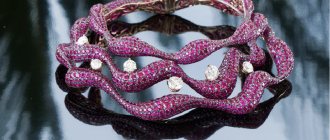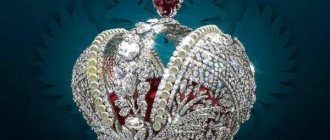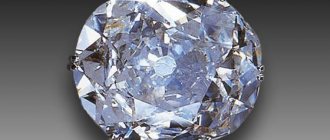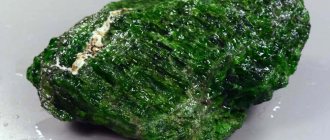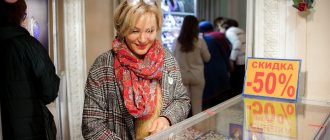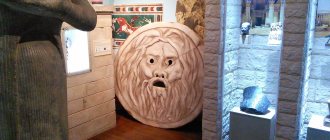The works of the Faberge jewelry company have been steadily increasing in price for a hundred years. Faberge is an ideal art investment with guaranteed high returns for long-term and short-term investments. Over the past 10 years, works of art from the late 19th and early 20th centuries have been in great demand at auctions and fairs. But the heirs of the famous jewelry family receive nothing from sales. What destroyed the legendary jewelry company? Who owns the world famous brand today? What business interest did he have when he bought the Fabergé collection from the Forbes family and opened a museum in the Shuvalov Palace in St. Petersburg five years ago?
Faberge fled. Faberge remains
September 1918. Petrograd. Everything is mixed up in the house on Bolshaya Morskaya, 24. Its owner, 72-year-old court jeweler Carl Faberge, and his eldest son Eugene are hastily packing their things. Shots are heard outside the windows, and the doorbell is constantly ringing: panicked clients are bringing jewelry to Faberge for safekeeping.
There are several months left before the publication of the All-Russian Central Executive Committee decree “On the abolition of private ownership of real estate in cities.” Carl Faberge will not wait for the expropriators to arrive. The owner of a fortune worth millions of dollars flees to Europe under the guise of a courier.
Advertising on Forbes
His wife, daughters-in-law, six grandchildren and son Nikolai already live in Europe. Three other sons, Agathon, Evgeniy and Alexander, remain temporarily in Petrograd, trying to save the company from collapse.
However, escape was not salvation for Carl Faberge, but a tragedy. He wandered around the world, and terrible news came from Bolshevik Russia: houses, dachas, shops and workshops were looted, property and jewelry were stolen, his middle son Agathon was twice arrested and imprisoned.
The fortune of the Faberge family was melting, and with it the health of the head of the company. Carl Faberge could only live without his company for two years.
Sunset
In 1915-1916, most of the best specialists of the enterprise were drafted into the army. The Moscow branch produced grenades and shell casings, not silver items. Delivery of materials has become more difficult. But the court and customers were waiting for new works. The company continued to operate for some time after the revolution. But at the end of 1918, Carl Gustavovich Fabergé, aged seventy, emigrated to Switzerland, closing his mansion on Bolshaya Morskaya Street. He left Russia, his sons and his life’s work, dreaming of returning home, but he died three years later in Lausanne, never seeing his homeland again.
The maestro left with one suitcase in his hands, and it is unknown what happened to his property, valued at more than 45 million rubles. This is the last of the mysteries left by the skilled creator.
Not just eggs
Today, about 250,000 items are known that were created by the Faberge jewelry company over 45 years (1872–1917). Carl Faberge was an artist, a gemologist, and a restorer. But his main talent was entrepreneurial: Faberge gathered around him the best artists of his time. In total, he employed 500 people, from salespeople to accountants. It was a huge jewelry empire, including workshops, design studios, shops and branches (in Moscow since 1887, in Odessa since 1890, in London since 1903 and in Kiev since 1905).
The House of Faberge produced diamond tiaras and cigarette cases, rings and earrings, silverware and icon frames. In Faberge's workshops, master stone-cutters also worked, creating objets de fantaisie, figurines of animals and people, made from solid pieces of stone and using complex techniques of enamel and Florentine mosaics.
Faberge store in St. Petersburg. 1910 Getty Images
But today we say “Faberge” - we mean “eggs”: Faberge created decorative Easter eggs in industrial quantities. Small elegant eggs-trinkets of various styles and finishes, precious pendants that were hung around the neck, on a belt, on brooches, and collected into necklaces. Prince Felix Yusupov recalled how “at balls, dozens of Faberge eggs scattered across the sparkling parquet floor.” And according to the recollections of Muscovites, in the 1950s, an antique store on Arbat was literally littered with Faberge eggs.
The imperial family made jewelry eggs a fetish. The first surprise egg “Chicken” was ordered by Emperor Alexander III as an Easter gift to Empress Maria Feodorovna in 1885. The last completed (by 1917 there were still two unfinished) imperial Easter eggs was the “Order of St. George,” created in 1916 from gold, silver, bone, and rock crystal. (Both the first and last eggs are now on display at the Faberge Museum in the Shuvalov Palace in St. Petersburg.)
Imperial eggs are those given by Russian Emperors Alexander III and Nicholas II to their spouses and mothers. At the moment, out of 50 imperial eggs, the whereabouts of only forty-three are known.
In addition to the imperial ones, the Faberge company also made luxurious Easter eggs on orders from other important clients: merchant Varvara Kelch (7 eggs); the Faberge company made one Easter egg each for Prince Felix Yusupov, Duchess Consuelo Marlborough, Baron Rothschild and oil industrialist Nobel.
Carl Faberge became famous for making jewelry of the highest quality.
Carl Faberge was mainly engaged in the manufacture of jewelry eggs of amazingly fine and filigree work.
As soon as you say “Faberge eggs,” your memory brings to mind amazing works of art made of precious metals and stones that the august family was proud of.
It was Carl Faberge, who stood at the head of the German community in St. Petersburg, who founded the Russian jewelry school, the main principle of which was the highest and impeccable quality.
From time to time, items from the Faberge jewelry house appear at world auctions and go to buyers for millions of dollars.
From the biography of Carl Faberge:
Peter Carl Faberge is a Russian jeweler with European roots. German and Franco-Danish blood flowed in the veins of the skilled craftsman with an admixture of Estonian, but Faberge is a great Russian jeweler.
The future jeweler was born on May 30, 1846 in St. Petersburg.
The mother of the famous master is Danish Charlotte Jungstedt, the artist’s daughter. His father, Gustav Faberge, was from the city of Pärnu (Estonia) and came from a German family. He was a descendant of Germanized French Huguenots who moved to Prussia after the revocation of the Edict of Nantes.
In 1841, Faberge Sr. received the title of “Jewelry Master” and in 1842 founded a jewelry company in St. Petersburg on Bolshaya Morskaya Street at number 12, but 20 years later he moved to Dresden.
Karl's artistic abilities were discovered in childhood. The son was keenly interested in jewelry, and his father gave him an excellent education. First, in St. Petersburg, the boy was sent to a private gymnasium. Then the young man studied commerce in Dresden.
After a long journey through European cities, Karl studied jewelry making in Frankfurt with master Joseph Friedman.
Having enriched himself with technical knowledge, Faberge studied the management of the enterprise and in 1864 returned to St. Petersburg. In his father's workshop and in the Hermitage, the young jeweler restored ancient jewelry.
Faberge Jewelry Workshop
In 1870, Gustav Faberge, who lived in Dresden, transferred powers to his 24-year-old son and made him the head of the St. Petersburg company. At first, there were 100 workers on its staff: Karl looked after many skilled craftsmen when he traveled around Europe.
Soon the company of Carl Faberge became a famous trading house. He produced both fabulously priced jewelry and mass-produced products. In 1914, a series of copper cups and cigarette cases went on sale. But the greatest fame for the House of Faberge, of course, came from jewelry Easter eggs: 54 examples were created in the workshop for the royal family.
Carl Fabergé married only once: his wife in 1872 was a girl named Augusta Julia Jacobs. In 1874, Augusta gave birth to her husband’s first child, who was named Eugene. He followed in his father's footsteps, learned jewelry making, worked in his parents' workshop, and immigrated to France in the early 1920s.
In 1876, his second son, Agathon Faberge, was born. In the spring of 1895, he joined the family business, and in the late 1890s he became an appraiser for the imperial court.
Agathon Karlovich's relationship with his father went wrong after he was accused of theft (later a family friend admitted to the theft). In the 1920s, the son of the famous jeweler worked as a commissioner of Gokhran. In 1927, he fled to Finland, where he lived in poverty.
The third son of the royal jeweler, Alexander, was born in 1877. He immigrated to Paris and founded the company with his brother Eugene.
The fourth, youngest, son of Karl, Nikolai, was born in 1884. He became a jewelry designer. Since 1906, he worked in a branch of the Faberge company in the capital of Britain.
At the age of 56, the head of the jewelry house fell in love with the 21-year-old cafe singer Amalia Kriebel, a Czech woman. The respected jeweler of the Romanov family did not intend to divorce his wife, but he could not overcome his passion for young Amalia. Every year, Carl Faberge went to Europe for 3 months, taking the singer with him.
In 1912, Kriebel married a prince of an old Georgian family and took the surname Tsitsianova. She left her husband immediately, but did not break the connection with Karl. Amalia is called the second Mata Hari. Tsitsianova was recruited by the Germans and Austrians. Faberge helped her get to Russia during the war. In the spring of 1916, Amalia was arrested and exiled to Siberia. The last lover never met with Carl Faberge, and the jeweler had difficulties due to his connection with an Austrian spy.
Faberge Jewelry Factory
After the October Revolution, the imperial jeweler's factories and stores were nationalized. In Petrograd, the Bolsheviks expropriated finished goods and stocks of precious stones and metals without paying a penny of compensation. The sons of Carl Faberge managed to take a few items to Finland.
The authorities sold the confiscated masterpieces, filling the coffers of the young state. Emmanuel Snowman, a representative of the British trading house Wartski, purchased six Easter eggs from the Faberge store in Petrograd.
In the fall of 1918, Carl Faberge secretly fled to Riga: the royal jeweler was afraid of arrest and execution. After the Bolshevik invasion of Latvia, the master left for Germany. When Berlin was engulfed by the November Revolution, Faberge moved to Frankfurt am Main, where he also did not stay long.
Faberge spent the last years of his life in Wiesbaden. After the revolutionary upheavals and confiscation of property, the famous master lost heart and repeated that “there is no more life.”
Doctors prescribed the 74-year-old jeweler a calm and measured life, strictly forbidding him to smoke: Faberge had a heart condition. Relatives transported the head of the family to the shore of Lake Geneva, which was famous for its climate. An entrepreneur robbed by the Bolsheviks, who lost his life's work and - according to various estimates - $500 million, not counting real estate, never recovered from the blow.
On September 24, 1920, Carl Faberge, despite doctors' prohibitions, lit a strong cigar. I didn’t have time to fully enjoy it: I died after smoking only halfway. Faberge was buried at the Grand Jas cemetery in Cannes.
Jewelry art and business of Faberge:
In 1870, Gustav Faberge, who lived in Dresden, transferred authority to 24-year-old Karl and made him head of the St. Petersburg company. The young man’s talent was so bright and extraordinary that already at the age of 24 he was able to take over his father’s company.
10 years later, products from the House of Faberge went to the Moscow art and industrial exhibition, where they were noticed and appreciated by Tsar Alexander III. From that moment on, the jeweler’s biography was inextricably linked with the imperial family, which patronized Carl Faberge and popularized his products in Europe. The Romanovs order jewelry from the jeweler, which they give to relatives in Denmark, Britain, and Greece.
In 1900, the Russian master was awarded the title “Master of the Paris Guild of Jewelers” and awarded the Order of the Legion of Honor established by Napoleon. The main building of the company appeared on Bolshaya Morskaya Street in the city on the Neva: the house was designed by a family relative, Karl Schmidt. On the ground floor there were workshops and a store opened, the other three floors were occupied by the family.
The first jewelry egg by Faberge appeared in 1885. The emperor ordered the product for his wife Maria Feodorovna as an Easter gift. The egg is called “Chicken” or “Chicken”. In comparison with the others, the product looks simple: white enamel on top, inside - in a golden “yolk” - a hen made of colored gold, in which a ruby crown was hidden.
The idea of the egg in which the surprise was hidden did not belong to Carl Faberge: the first examples of eggs appeared in the 18th century. Similar items were kept in the treasury of the King of Denmark, the father of the wife of Alexander III, née Maria Sophia Frederica Dagmar. The Russian Tsar wanted to give his wife a gift that would remind her of her homeland.
The Empress liked the Easter surprise so much that Carl Faberge became the court jeweler and received an order: every year to delight the august family with a new precious egg with a secret.
Nicholas II inherited the tradition and doubled the order: Carl Faberge annually produced 2 eggs for Easter – for the Tsar’s mother and his wife.
The sketch of the egg was approved by the head of the trading house, after which the best craftsmen got to work. History has preserved the names of Mikhail Perkhin (Karelian nugget), August Holstrom, Eric Collin. Under the Romanovs, the Fabergé trading house grew to 500 employees.
The “fashion” for donating Faberge Easter eggs, which was introduced by the Romanovs, spread throughout Europe: the Russian jewelry house received orders from abroad. 15 products are known, 7 of which Carl Faberge created by order of gold miner Alexander Kelch. The master and his students made the remaining 8 eggs for Felix Yusupov, Duchess of Marlborough, and the Rothschilds.
The products of the Russian jeweler amazed with unexpected solutions. Carl Faberge boldly experimented: he could make the basis of a brooch a Karelian birch tree, setting a piece of wood in diamonds. He often worked with semi-precious stones and materials considered “non-jewelry”. But the work was so meticulous that it amazed the most demanding customers.
Faberge's workshop was famous for its unique enamel: hundreds of color shades and the guilloche technique (patterned notches on the main background, covered with layers of varnish) turned the product into a masterpiece. Enameled cigarette cases, watches, boxes, snuff boxes and sets seemed to glow from within and seemed multi-layered.
The Faberge trading house produced both exorbitantly priced jewelry and mass-produced products. For example, in 1914, a series of copper cups and cigarette cases were on sale. But the highest fame for the House of Faberge was brought by 54 pieces of jewelry Easter eggs for the royal family.
45 interesting facts about precious items and Easter eggs of the Faberge jewelry house:
1. Faberge is, perhaps, one of the most famous jewelry brands today. And all thanks to the precious Easter eggs that were produced by this jewelry house for the Russian imperial family.
2.Carl Faberge was given complete creative freedom; he could create precious eggs on any theme. But there was still one rule: every egg should have a surprise.
3. Faberge always followed this rule. Each of his precious eggs contained a miniature wonder: a tiny diamond replica of the royal crown or ruby pendant, a mechanical swan, an elephant, a gold miniature of the palace, 11 tiny portraits on an easel, a model of a ship, an exact working replica of the royal carriage and much more.
4. The British collection of Faberge products is one of the largest in the world. In addition to the legendary eggs, it contains several hundred jewelry masterpieces: boxes, frames, animal figurines and personal jewelry of members of the Imperial Houses of Russia, Great Britain and Denmark.
5. Despite the size of the British collection, this is only a small part of the 200,000 pieces of jewelry produced by the Faberge jewelry house.
6. Queen Elizabeth II owns three Imperial Fabergé eggs. Her collection includes Faberge Easter eggs: “Colonnade”, “Basket of Flowers” and “Mosaic”. Particularly noteworthy is the “Flower Basket”, the flowers in which look fresh and surprisingly realistic.
7. The prototype of Faberge's first work was an egg from the Danish royal treasury. In the 18th century in Denmark, jewelry Easter eggs were made with a surprise chicken inside. According to the principle of a nesting doll, a crown was kept in a chicken. Emperor Alexander III gave his wife Maria Feodorovna, the former Danish princess Dagmar, an analogue - a work by Carl Faberge. This gift served as the basis for the entire collection.
8. Carl Faberge is a hereditary jeweler and a whole concern worked on royal gifts. Among the masters are the most famous Mikhail Perkhin and the only lady artist Alma Pihl, who invented frost on crystal - “Winter Egg”. The team of jewelers spent a year on each job, just before Easter.
9. In 1882, the All-Russian Art and Industrial Exhibition was held in Moscow. It was there that Emperor Alexander III and his wife Maria Feodorovna noticed the works of Peter Carl Faberge. So Faberge received the patronage of the royal family and the title of “Jeweler of His Imperial Majesty and Jeweler of the Imperial Hermitage.”
10.Faberge had not only creative freedom, but also three conditions for a court jeweler: when starting work, Carl Faberge had to adhere to the shape of an egg. Connect the content with the life of the royal family and avoid repetition. The Emperor was always impatiently interested in the plot of the new work, to which the jeweler replied: “Your Majesty will be pleased.”
11. In 1885, Tsar Alexander III, deciding to surprise his wife, Empress Maria Feodorovna, gave her a special gift - an egg with a secret. It was a precious egg, covered in white enamel, with a gold stripe running across it. It opened, and inside was a golden “yolk”. In it, in turn, sat a golden hen, inside of which there was a ruby crown and pendant. The Empress was delighted with such a gift, and Alexander III presented his wife with a new precious egg every Easter.
12.This tradition was continued by the son of Alexander III, Nicholas II, who gave precious eggs to his mother and wife for the Easter holidays.
13. Thanks to the instant success of the first product, Faberge received a permanent order from the imperial court for Easter eggs.
14.At first, he created 10 pieces in a row for Tsar Alexander III, which he gave to his wife Maria Feodorovna every year until his death in 1894.
15. He then completed 44 more eggs - between 1895 and 1917 - commissioned by Tsar Nicholas II as gifts for his mother, then the Dowager Empress, and his wife, Alexandra Feodorovna. In total, he created 54 Easter eggs by imperial order.
16. It can also be assumed that several eggs were presented at one time to other members of the imperial family.
17. To this day, 45 Easter eggs made according to the royal order have survived, a photograph of another, and five more eggs are known from descriptions.
18. One of two unfinished Easter eggs, work on which was carried out in 1917, has also been preserved.
19. Faberge products were famous in Europe. Numerous royal and princely relatives of the Russian Imperial Family in Great Britain, Denmark, Greece, and Bulgaria received jewelry as a gift, valued it very much and passed it on to inheritance.
20. The revolution of 1917 forced Faberge to close the company. The Bolsheviks, trying to replenish the treasury of the “world's first communist state,” sold off Russian artistic treasures. They plundered churches, sold paintings by old masters from the Hermitage Museum and took over the crowns, tiaras, necklaces and Faberge eggs that belonged to the Emperor's family.
Hallmark of the House of Faberge
21.In 1925, a catalog of valuables from the imperial court (crowns, wedding crowns, sceptres, orbs, tiaras, necklaces and other jewelry, including the famous Faberge eggs) was sent to all foreign representatives in the USSR.
22. Part of the Diamond Fund was sold to the English antiquarian Norman Weiss.
23. In 1928, seven “low-value” Faberge eggs and 45 other items were removed from the Diamond Fund.
24. However, it was precisely thanks to this that the Faberge eggs were saved from being melted down. This is how one of Faberge’s most incredible creations, the Peacock Egg, was preserved. Inside the crystal and gold masterpiece was an enameled peacock. Moreover, this bird was mechanical - when it was removed from the golden branch, the peacock raised its tail like a real bird and could even walk.
25. Not only precious metals were used in jewelry. In the pre-revolutionary years, many craftsmen from the Faberge company went to the front, and in difficult times for the country, Alexandra Feodorovna received a “Military Steel” egg as a gift.
26. In 1917, an egg was made from Karelian birch for Maria Feodorovna.
27. Maria Fedorovna was able to take out only one gift - the “St. George’s” egg - in 1918, when leaving Russia for Denmark.
28. The fate of the seven Faberges is unknown today; most likely, they are in private collections.
29. The fate of the travel bag egg, created in Faberge’s workshop in 1889, is also shrouded in mystery. The last time this egg was allegedly seen in a London store was in 1949. According to rumors, it was sold to an unknown person for $1,250.
30. One of the lost imperial Easter eggs was found in a completely surprising way. An American bought a golden egg studded with precious stones for $14,000 for scrap and wanted to resell it at a better price. But when there were no buyers, he decided to look for an outlandish souvenir on the Internet and was surprised to discover that it was the work of Faberge. After examination, it was confirmed that this was one of the long-lost imperial Easter eggs. Instead of a $500 profit, the dealer made about $33 million by selling the egg to a private collector.
31. The sign of the double-headed eagle - the Faberge mark - gives artistic value to jewelry eggs and adds additional zeros to the market value. Many people tried to work “like Faberge”, and at the end of the 20th century there was even an exhibition of fakes in New York.
32.Authentic works are in the collections of five countries - Russia, USA, Great Britain, Monaco, Switzerland.
33.Faberge eggs and criminal interest in them are a favorite topic for filmmakers. Soviet - “The Investigation is Conducted by Experts” and Western - one of the Bond series, pictures with Mick Jagger, Audrey Hepburn, Martin Lawrence. And for the film “Ocean’s 12” they made a metal copy of a Faberge egg. The work cost four thousand dollars.
34. When the Kelch couple divorced, the entrepreneur’s ex-wife took her Faberge collection with her to Paris. Six eggs eventually ended up in the United States. Initially, the eggs were mistaken for items from the imperial collection, and only in 1979 it was established that all seven eggs belonged to the Kelch collection.
35.After the revolution, the Faberge brand was resold several times. Unfortunately, the big name was used by a toilet cleaner, shampoo and cologne company.
36.The last company to acquire the brand, Pallinghurst Resources, decided in 2007 to return it to its former glory by relaunching jewelry production.
37. Two years later, through the efforts of Peter Fabergé’s granddaughters Sarah and Tatiana, the world saw new Faberge jewelry for the first time since 1917. These products are clearly far from those that were made at the beginning of the 20th century, but, nevertheless, today you can buy jewelry from Faberge at a price of $8,000 - $600,000.
38. Jewelry fantasies on an Easter theme haunt fashion designers. Entire fashion collections are created based on the works of the imperial jeweler.
39.Valentin Yudashkin’s collection with egg-shaped dresses in the Faberge style created a sensation at the show in Paris. Pierre Cardin was the first to congratulate his young colleague on his success.
40. Now the world's largest collection of eggs is located in St. Petersburg, in the Faberge Museum.
41. The second largest is in the Armory Chamber. One more is on display in the Hermitage and the Mineralogical Museum.
42.Faberge justified the high status of the court jeweler by maintaining intrigue. 71 eggs were made, 54 were imperial. And every surprise is a miniature miracle.
43. The most famous is an exact copy of the coronation carriage of Nicholas II, the most unexpected are a manicure set and a map of the empire with the Trans-Siberian Railway. 44.Today these works of art are extremely rare, shrouded in mystery, and their value reaches up to $30 million.
45. In 2004, Russian entrepreneur and billionaire Viktor Vekselberg bought 9 eggs from Malcolm Forbes (including the first one, “Chicken”) for $100 million and returned them to Russia. Thanks to the businessman, the Faberge Museum appeared in St. Petersburg.
Memory of the famous jeweler:
*In Odessa, on the building of the Passage Hotel, where in the fashionable shopping arcades before the Bolshevik Revolution the jewelry salon of Carl Faberge was located, a memorial plaque was installed.
*On November 19, 2013, the Faberge Museum was opened in St. Petersburg at the Naryshkin-Shuvalov Palace.
*In St. Petersburg there is Carl Faberge Square.
*In Moscow there is a College of Decorative and Applied Arts named after Carl Faberge.
*In Kyiv there is a memorial plaque in honor of the famous jeweler.
*In Baden-Baden there is a Faberge Museum - the first in the world entirely dedicated to the works of the famous jeweler's company.
Faberge Museum in Baden-Baden
photo from the Internet
How Viktor Vekselberg bought the best private collection of Faberge
2018, Moscow. On Petrovka, 10, a few steps from the house where the Moscow Faberge store operated before the revolution, a jewelry boutique of the Louvre chain has been opened, one of two stores remaining from a network of 12 boutiques. In its heyday, a few years ago, when Louvre's flagship boutique was located at the Ritz Carlton, it sold Fabergé-branded items. The owner of the Louvre chain was then an antiques collector and entrepreneur Vladimir Voronchenko. Today Voronchenko is the director of the Faberge Museum in the Shuvalov Palace in St. Petersburg, the chairman of the board of the Link of Times Foundation, founded by Viktor Vekselberg in 2004 after purchasing the world's largest collection of Faberge from the Forbes family.
By purchasing item after item over 30 years, Malcolm Forbes assembled the finest Fabergé collection. Its value lies in the fact that it represents all areas of Faberge jewelry art.
Coronation egg, 1897 · cultural and historical foundation “Link of Times”. Faberge Museum in St. Petersburg
After Malcolm Forbes died, his sons decided to sell the collection: first 20 items went, then another 70, and then everything that was left of it.
The final auction of the Fabergé collection from the collection of Malcolm Forbes at Sotheby's in New York was scheduled for April 20–21, 2004. Every Fabergé collector considered it his duty to register for this auction.
However, two months before the auction, Sotheby's announced its cancellation. The reason is the purchase of the entire collection by a Russian businessman. For an auction house with a 250-year history, the event is unheard of, as well as for the global auction market. “This is an absolutely exceptional decision,” admitted the president and CEO of Sotheby's Holdings Inc. Bill Ruprecht.
The purchase amount has not been officially announced; market experts say $100–120 million.
In any case, the price was enough to convince Sotheby's to cancel the auction. Having parted with millions of dollars, Vekselberg purchased more than 200 items and became the owner of the world's most significant collection of Faberge items. And the second - after the Moscow Kremlin Museums - is a collection of imperial Easter eggs.
Advertising on Forbes
“Vekselberg saved a textbook museum-level collection from disintegration, preserving its integrity,” said Tatyana Muntyan, curator of the Faberge collection of the Moscow Kremlin Museums.
Like Malcolm Forbes, who exhibited his collection for free in New York for many years, Viktor Vekselberg did not hide his treasures. For nine years, the collection traveled to museums in Russia and the world - from the Moscow Kremlin Museums to the Vatican Museums and the National Museum of India. I visited New York, Berlin, Rome, Monaco, Delhi, Dubrovnik, Italian Bari, of course, and Russia - from Moscow to Khanty-Mansiysk. In the outback, the collection caused a terrible stir.
Perm pensioners, wanting to get to the exhibition, almost broke the doors of the museum.
Five years ago, a permanent exhibition opened - the Faberge Museum in St. Petersburg, in the Shuvalov Palace, specially rebuilt for this purpose.
Perhaps, when purchasing the Forbes collection, Viktor Vekselberg was guided not only by altruistic goals. In 2007, the owner of SUAL (the Siberian-Ural Aluminum Company later became part of Russian Aluminum), Viktor Vekselberg, and the former director of SUAL, South African businessman Brian Gilbertson, quarreled over the rights to the Fabergé trademark. The rights to Fabergé Limited remained with Brian Gilbert. Fabergé Limited stores have opened not only in central London, but throughout the world. And the network of Russian jewelry boutiques Louvre refused to distribute Fabergé jewelry.
How did it happen that the rights to Fabergé do not belong to the descendants of the Fabergé family and pass from hand to hand?
Advertising on Forbes
The most famous masterpieces of Carl Faberge
Under the leadership of the brilliant master, the employees of his family company, according to the most conservative estimates of experts, produced about 200,000 various products until 1917. They include a variety of unique jewelry, fine tableware, and antiques. And yet, some of the most famous masterpieces of Carl Faberge include:
- “Faberge Eggs” (1885-1917) is a series of magnificent jewelry (71 pieces) made for Russian emperors and a small group of private individuals. 65 masterpieces have survived to this day, which are currently in closed collections and national museums in different countries. Unfortunately, most of the unique precious works were sold for next to nothing in the 1930s by the Bolsheviks as part of a program to find funds for the industrialization of the national economy of the USSR.
- “Gentleman’s Set” (1905) is an original still life made from valuable materials. Despite its very ordinary appearance, the composition is a unique piece of jewelry. The egg yolk is made of amber, the newspaper, flies and fish are made of silver, and the brick stand is made of jasper.
Carl Faberge is without a doubt one of the most famous jewelers in the history of world art. His unique contribution to Russian culture is comparable in its greatness to the achievements of Pushkin, Tchaikovsky and Repin. Fortunately, most of the great master’s unique masterpieces can still be seen today by millions of people on our planet in museums and exhibitions.
Travel bag and six suitcases with treasures
On the eve of his flight from Petrograd, Carl Faberge was on the safe side—or so he thought. Karl donated his large house with a massive facade, lined with gray-pink and red granite, where the Faberge family lived for 18 years, for free rent to the Swiss mission.
This was reasonable: in March 1918, the Soviet government issued a decree protecting the property of foreigners. And in the Faberge house the jewelry of the family and clients was kept. The surviving inventory values the items at 1,603,614 rubles in gold in 1917 prices (825.6 million rubles at today’s exchange rate). But besides Karl and Eugene Faberge, only the mission cashier named Zimmerman knew about this. The jewelry was packed in a large suitcase and placed in a armored room with a German Arnheim safe elevator, the most reliable in the world. Faberge also placed six suitcases with family belongings in the same safe.
For storing things in his own house, Faberge paid the Swiss monthly 1% of their value and even drew up a formal receipt for the amount of 100,000 rubles. There was also a second receipt with a list of jewelry and their sketches, which can still be used to track things on the antique market.
The Swiss ambassador Edouard Odier settled in the house, which seemed to Faberge to be quite reliable protection. After Lenin was seriously wounded and the head of the Investigative Committee Uritsky was killed on August 30, 1918, the Red Terror was declared. Faberge fled. And a month later, the Swiss ambassador ordered to transfer all his suitcases, as well as Faberge’s belongings, including a suitcase with jewelry, to the Norwegian Embassy, at Moika, 42.
The next night, all Fabergé's belongings and jewelry were stolen from the Norwegian embassy.
Two weeks later, Switzerland broke off diplomatic relations with Soviet Russia, and Mr. Odier safely returned to his homeland.
Advertising on Forbes
When the expropriating security officers finally reached the Faberge house on Morskaya, the only thing they left intact was the Arnheim safe elevator. Couldn't open it. The treasures from Faberge's bag were never found. But some things sometimes appear on the antique market (for example, a cigarette case made of two-tone gold with a sapphire clasp) and then immediately disappear.
For more than 50 years, the descendants of the Fabergé family sought compensation from the Swiss authorities, but lost all their claims and received a final refusal in the 1970s.
The story with the traveling bag was only the beginning of the tragic downfall of the company. The Bolsheviks confiscated all valuables from Petrograd and Moscow stores, warehouses, workshops and factories. At the same time, the antique markets of Europe were overwhelmed with Fabergé jewelry exported from Russia and counterfeits of the company's products. The heirs did not receive a single ruble from the sale of the stolen and exported goods.
The Fall of the Faberge Empire
Most of the Russian population at that time lived in dire poverty. Social stratification reached catastrophic proportions: the gap between rich and poor was insurmountable.
This was compounded by the memory of the loss in the Russo-Japanese War and rising inflation. Discontent grew.
The workers were in despair. But Faberge did not notice this. He was warned that an explosion was inevitable, the situation was catastrophic.
At the end of 1917, a decree on gold and platinum was issued. Now one person had the right to own a gold product weighing no more than 68 grams. But a cigarette case or watch from Faberge could weigh many times more.
As a result, in 1918 the company was nationalized by the Bolsheviks, and Faberge was forced to sign a decision to liquidate the company. The jeweler's dacha near St. Petersburg was looted and destroyed, the safe was broken into. Karl had to flee Latvia, then to Germany.
Multifaceted, like a processed diamond, the brilliant jeweler did not have the strength of stone. He died of a heart attack without recreating his empire in 1920 in Lausanne.
The overthrow of the monarchy, the execution of the royal family, the rise to power of the Bolsheviks - all this turned out to be a fatal blow for the Faberge empire. The death of Faberge, however, was not the death of the brand he created.
Quarrels in the Faberge family, slander against the son of Agathon
Things weren't going well for Faberge several years before the revolution. The annual turnover of the company at the peak of its activity was more than 1 million gold rubles. The first tangible blow was dealt by the First World War. Revenue in Europe fell: in 1915, the store in London, which had been operating since 1903 under the leadership of his son Nicholas, had to be closed.
By the beginning of the revolutionary events, Karl was already over seventy, he was tired and wanted to step away from active management of the company. The elder Faberge was looking for a reliable partner who could be entrusted with all management issues. Why not for sons? Nikolai lived permanently in London, Alexander - in Moscow. Karl quarreled with the middle one, Agathon, and fired him from the company. And he seemed to have little faith in his son Evgeniy’s abilities.
Advertising on Forbes
As a result, Otto Bauer, director of the company’s board, became Carl Fabergé’s partner. A year before the revolution, the company was reorganized into the “Share Partnership” K. Faberge." Bauer received a general power of attorney from Carl Faberge, according to which he was given the management of affairs and the right to make decisions. Otto Bauer, unlike the sons of Carl Faberge, enjoyed complete trust, and this became the jeweler’s fatal mistake.
In 1922, partner Bauer informed Faberge’s heirs that he could not give away any of their property - “everything was taken away by the expropriators.” The Faberge family did not believe him and considered him a thief. Evgeniy tried most actively to return the property. And through the former Minister of Justice of Latvia, he achieved the arrest of Bauer. During interrogation in prison, Bauer said that nothing remained of Faberge’s legacy except the Breguet watches. Evgeniy refused to take the watch.
On October 20, 1918, a month after fleeing Russia, Carl Faberge drew up a will, which listed apartments, lands, a dacha, collections of art objects, including Japanese items, a collection of geographical maps, engravings, watches, as well as furniture, books and other property. But in fact, Carl Faberge no longer owned any of this: the will had no value for the heirs. According to his will, Carl Faberge disinherited his son Agathon. He also released his other sons from obligations towards his brother in the event that Agathon himself opens or takes any part in a business competing with the K. Partnership. Faberge." What is the reason? Agafon, who served as the company's commercial director, was accused of embezzlement. And after the death of Bauer, who once accused Agathon, one of the employees confessed to this crime. Karl did not live to see this; he died without forgiving his son.
However, it was Agathon who had a strong business acumen and was well versed in the financial intricacies of business. Agathon's entire subsequent life confirms the strength of his character and healthy adventurism, which his brothers did not possess.
Composition “Cornflowers and Oats” Getty Images
Agathon lived in Soviet Russia for 10 years: he was imprisoned twice and endured many interrogations. The security officers persistently searched for the treasures hidden by the Faberge family. For a couple of years, Agathon managed to work as an expert at Gokhran, where Leon Trotsky assigned him. All these years, Agathon's wife Lydia and their five children lived in exile - they left a year after the revolution. Agathon himself was not released from Russia. In 1927 he fled. He prepared thoroughly for his escape: he sent his property through the Finnish consulate, including a collection of postage stamps (Agathon was a world-class philatelist), to Finland by diplomatic mail. Smuggler Petr Pukkila helped organize the escape. Agathon fled to Finland with his second family (wife Maria Borzova, formerly his eldest sons' bonne, and their son Oleg) on the night of December 11, 1927.
Advertising on Forbes
“My dad thought of everything in advance. And we didn’t take anything with us on the road except warm clothes. In advance, long before that night, he sent all the valuables to the Estonian embassy, and from there, by diplomatic mail, we received everything safe and sound in Helsingfors,” Oleg Faberge wrote in his memoirs.
Carl Faberge and his sons did not do the most important thing: they did not register the name of Carl Faberge as a trademark.
After the revolution, Europe and America were overwhelmed by a wave of Fabergé counterfeits. There was even such a concept as Fauxbergé, that is, “Falseberg”. One of those who established the industrial production of counterfeits was the “great friend of Soviet Russia and the Soviet Union,” American billionaire Armand Hammer.
Working with partners
Until 1908, the Faberge company did not have its own stone-cutting production. Moreover, the company began selling animal figurines made of semi-precious stones in the early 1980s.
Stone cutting work was outsourced to third-party craftsmen. All work based on the company's drawings and models was carried out at the Karl Werfel factory in St. Petersburg and at the Stern enterprises in Oberstein.
In 1908, Faberge bought the Werfel factory. This production formed the basis of Faberge's stone-cutting activity.
Moreover, at first these were rather simple and clumsy figurines. However, over time they grew into real works of stone art.
At the turn of the 19th and 20th centuries, the company’s craftsmen mastered the technique of volumetric Florentine mosaic. It contained a large number of items, including a number of animal figurines.
Stone cutting as an independent activity did not last long. The company's activities completely ceased in 1918. And the previous years could be called a period of decline. The First World War and revolution destroyed the country in which such an enterprise as the Faberge firm could exist.
Despite this, the stone cutting industry brought fame and prosperity to Carl Faberge's company. Contemporaries called the jeweler “Cellini of the North” and considered him a true artist. At the same time, he was also an amazing manager.
Revolutionaries and adventurers. Who and how in Soviet Russia made money from Faberge
The American Armand Hammer, the son of emigrants from Odessa, came to Russia in 1921 and quickly found a common language with Lenin: in exchange for supplies of medicines and wheat to the devastated country, Hammer received from the leader of the proletariat the right to export objects of art and many other preferences. He said: “Becoming a millionaire is not difficult. We just need to wait for the revolution in Russia.”
Hammer lived in Soviet Russia for nine years, representing the interests of large Western companies, founded his own pencil factory and managed to transport a huge amount of valuables to Europe.
Ironically, Hammer was settled in the house of the Merchant Society on Kuznetsky Most, where Faberge's store and studio of the company's artists had previously been located.
Advertising on Forbes
In 1927, the director of the Kremlin Armory, Dmitry Ivanov, achieved the receipt of 24 imperial Easter eggs from foreign exchange reserves to the Kremlin funds. However, in 1930, the authorities seized 11 of them for export. These imperial eggs, like many other treasures, ended up in Hammer's hands. “He bought some things at the price of the material - for example, the imperial Renaissance Easter egg, for 1,500 gold rubles, while the imperial family paid 4,750 rubles for it,” says Tatyana Muntyan, curator of the Fabergé collection at the Kremlin Museums.
Hammer exported Fabergé treasures from Russia and sold them at antique markets, and later, together with his brother, opened a gallery in New York and organized the mass production of Fabergé Easter eggs and stone-cutting figurines. Hammer managed to gather craftsmen from Faberge's workshops around him and acquire copies of the signature St. Petersburg hallmarks and imperial fonts. A consultant worked in his gallery, “a specialist in Russian Faberge.” He and the Hammer brothers' agents passed off the counterfeits as rare duplicates of original Faberge items or even as originals.
At the same time, auctions were held in Europe and America, one after another, at which agents of the Soviet government sold authentic Faberge items. For example, at the auction of the German antique company Rudolph Lepke's Kunst-Auctions-Haus in Berlin in 1927, the most significant Faberge sales of the pre-war period took place.
In 1933, four more eggs were removed from the Armory. Its director Dmitry Ivanov, unable to bear the looting of the collection and the destruction of monuments in the Kremlin, committed suicide. The day after his death, a representative of the Soviet Antiques came to the Armory with a mandate to seize another 120 items.
Against this background, the business of the Hammer brothers flourished: by advertising, by the 1930s they created a real cult of Faberge in Europe and the USA.
Advertising on Forbes
Wartski Gallery, one of the most famous and authoritative Faberge dealers on the antique market, also received items directly from Soviet Russia: Wartski owner Emmanuel Snowman personally went shopping. But most of the Fabergé items were brought to London in 1927 by Wartski’s business partner: after talking with the Soviet representative in Paris, he took out a huge suitcase of jewelry. Thus, the Wartski gallery became the European center for the sale of Faberge works.
Fabergé and Fauxbergé: originals and fakes
“In New York, on the famous 47th Street, almost every jeweler with ambitions keeps in his desk drawer the entire necessary set of Faberge hallmarks,” said applied arts expert Vladimir Teteryatnikov. Historian Georgy Zuev in his book “The Fabergé Empire” confirmed that jewelry workshops in New York “put out on the market almost perfect fakes, with exact copies of hallmarks and ciphers.”
About 8–10% of the turnover of Faberge objects are fakes, says Vladimir Voronchenko, director of the Faberge Museum in St. Petersburg. According to him, there are also semi-fake things - when several items that cannot be restored are taken and one is made from them. “America, Ukraine, Greece, Russia are the main countries producing fakes,” Valentin Skurlov, an expert at the Christie’s auction house and a researcher of the Faberge heritage, told Forbes Life. — The most famous works of Faberge are least often counterfeited - Easter eggs, surprises in them, some jewelry, mechanical automaton dolls and watches, especially with guilloche enamel. Partly because these subjects are already well studied, and partly because of their complexity. Faberge always used Swiss movements, so his things still work a hundred years later, but it is extremely difficult to counterfeit such a mechanism.”
Carl Fabergé store facade ·Getty Images
More often, for example, stone-cutting plastic is counterfeited. “It's easier and cheaper. The main thing that is required is to select stones from the right deposit, says Vladimir Voronchenko. “The art of stone processing in Russia has always been at a high level.” “It is important to understand the difference between fakes with false stamps and things stylized “like Faberge” that are not repeating objects that have already been produced,” clarifies Valentin Skurlov. Collectors understand that fakes are inevitable, and try to turn such situations to their advantage: catalogs also publish a list of fakes, sections “Falsebergé”, Fauxbergé.
In 1931, Fabergé Inc. appeared on the European market. Perfumes and toiletries began to be sold under the Fabergé trademark. This is not just Fauxbergé, but a separate business.
Advertising on Forbes
And here, too, Armand Hammer could not do without.
How to buy the Fabergé brand for $25,000
Fabergé Inc. registered by Hammer's friend, Spanish businessman Samuel Rubin, an exporter of soap and olive oil. When the civil war began in Spain and there was no time for oil, Rubin, on the advice of Hammer, founded a new company, Fabergé Inc., which began producing cologne and perfume. The Faberge family accidentally found out about this in 1945. At the same time, the Fabergé brothers, Eugene and Alexander, tried to revive the family business: they registered the Fabergé & Cie company in Paris and opened a workshop where they repaired old products and produced new ones according to old sketches. Former masters of their father's company worked together with the sons of Carl Faberge.
The Faberge brothers tried to protect the family's rights to the brand and filed a lawsuit against Samuel Rubin. At the trial, it turned out that the Faberge brand never existed in the legal field; it was not registered.
Meanwhile, Rubin registered the Fabergé trademark in the United States. The litigation lasted six years. The Faberge brothers lost. As Valentin Skurlov explains, according to the court decision, Samuel Rubin could use the Fabergé name in relation to a wide range of product groups (from belts to bag linings), for which he paid Fabergé & Cie $25,000.
In fact, this is the only payment for the right to use the brand that the heirs of Carl Faberge ever received.
To this day, the Fabergé family receives nothing for the legacy of their ancestor. When Rubin's compensation was divided among all the heirs, each Faberge ended up with about $800, says Valentin Skurlov. Fabergé & Cie closed in 1960 after the death of Eugene, son of Carl Fabergé.
Advertising on Forbes
In 1964, Rubin sold Fabergé Inc. cosmetic company Rayette for $26 million. From that moment on, the brand began producing cosmetics, perfumes, personal care products, and jewelry.
In 1984, Riklis Family Corporation bought out Fabergé Inc. for $670 million.
In 1989, Fabergé Inc. acquired by the global corporation Unilever for $1.5 billion.
Unilever has not only registered the Fabergé trademark on a wide range of products around the world, but has also granted licenses to manufacture and sell selected products under the Fabergé brand. Along with glasses, perfumes, silverware, porcelain and other things, jewelry also occupied a modest place on the list. And then the brand finally got a little lucky.
In 1989, the German jewelry company Victor Mayer acquired exclusive rights to licenses for the production of jewelry and watches. For almost 20 years of the license, the company created a large number of new jewelry and Easter eggs in the style of Faberge made of gold and platinum with precious stones and enamels. Apart from this small company, few people were interested in the Fabergé jewelry line: in the USA, Fabergé was known as a cosmetics brand.
By 2006, Fabergé was still a FMCG brand. Although Unilever did make attempts to promote the jewelry line, it released “collections” of various jewelry items (mainly using Easter eggs) and sold them, along with glasses and porcelain, in department stores in New York. Fortunately, the attempts were not very successful and the company did not have time to completely discredit the jewelry brand.
Advertising on Forbes
It is not surprising that in the end, billionaire Viktor Vekselberg came up with the idea of returning the brand to its former rights and breathing new strength into it.
Vekselberg did not have time to recreate the world’s most famous Russian brand from ruins. His interests immediately clashed with the interests of his business partner. Both had to fight for the brand, and the matter ended in court.
Lean principles of the House of Faberge
See with your own eyes
The Faberge firm is a family business. The sons and brother of Carl Faberge worked with the children and relatives of other masters. This is how manufacturing dynasties were formed. There were few masters. And it was they who became Karl’s first teachers - he grew up in his father’s workshop. If you think about it in lean manufacturing terms, Carl Fabergé essentially grew up in a gemba.
Karl’s mother, Charlotte, also had a strong influence on the development of the great jeweler’s personality. She was the daughter of a Scandinavian art professor and constantly talked to Karl about art.
Just as Toyota was built on the values of the Toyoda family, family principles became the foundation.
Learn, improve
At the age of 14, Karl left with his family for Dresden. There he studied at the art and industrial school and then, at the suggestion of his father, at the Commercial College, where, among other things, he attended classes by Joseph Friedmann, the best jeweler in Frankfurt. In Paris, Carl Faberge spent 24 hours a day in the Louvre.
The pursuit of perfection was Carl Faberge’s life credo
Returning to Russia, Fabergé went to work for Hisquias Pendine, a prominent gold and silversmith in the Russian Empire. He mentored Carl for 10 years. Then Faberge decided that he would assemble a team that would include many talented craftsmen, and each of them would be famous in their field. And he succeeded.
Raise extraordinary people and form teams
The workshops were in full swing: jewelers mastered new processing techniques and experimented with non-standard materials - cork, wood, leather, etc. And the head of the company continued to work and study.
Thus, Faberge worked for hours in the Hermitage Antiquities Department: restoring damaged parts and resurrecting antique collections. Moreover, he made sure to describe each one.
He demanded the same dedication from each master of his company. And they worked in the Hermitage and the Armory Chamber of the Moscow Kremlin, painstakingly copying ancient products and sketching ornaments.
Neither Faberge nor his masters took a penny for their work - they did not send invoices to pay for their activities. Karl was extremely demanding of his employees; he could directly say what he did not like about the item being made.
A Faberge piece of jewelry had no right to be imperfect
Karl selected the most talented craftsmen. They had to have creative thinking, be able to pick up the idea of the head of the company and not only implement it, but also creatively develop it. Therefore, although Faberge valued and respected each employee, he did not make concessions.
He was also merciless to himself. Faberge could mercilessly criticize the sketch, forgetting about his own authorship. And then say: “This is what it means when there is no one to scold. I cursed myself." Each master, and the head himself, was primarily responsible for the quality of products in the Faberge company.
Create a sustainable work culture and lasting values
The main production of the Faberge company was located in St. Petersburg. In addition to it, 4 more branches were opened - in Moscow, London, Kyiv, Odessa.
The enterprise in St. Petersburg was advanced. Faberge even installed electricity. A canteen, a restaurant for workers, a doctor’s office... All this was done for the craftsmen of the Faberge company.
Moreover, at some point, Carl Faberge himself stopped directly producing jewelry. But he always directed and mentored the masters who supervised their specialists.
He wanted his employees to be as motivated as possible, so he built his production management system accordingly. So, he allowed each master of the company to organize his own small company. All of them worked under the Faberge brand.
Moreover, on a number of works the craftsmen had the right to put their initials next to the company’s mark. Thanks to this, Henrik Wigström, Fyodor Rückert, Mikhail Perkhin etched their names in the history of jewelry in Russia.
This is also why there have never been strikes at Faberge factories. He did not fire anyone unreasonably, not even the elderly. It can be said that Faberge adhered to the idea of lifetime employment.
However, they could be fired for violating the rules adopted by the company. There were only six of them, and they ensured the smooth operation of production.
Viktor Vekselberg's fight for Fabergé
At first, everything went well: the investment director of the Renova Group of Companies, Vladimir Kuznetsov, began negotiations with Unilever; the new asset was to be included in the Pallinghurst Resources investment fund. On a parity basis, the fund was controlled by Vekselberg's business partner in SUAL, South African entrepreneur Brian Gilbertson.
As the Vedomosti newspaper reported, together with his partners and son Sean, Gilbertson agreed to buy out the Unilever division, Unilever Lever Fabergé, the transaction amount - about $36 million - suited everyone.
Gilbertson is one of the principal owners of the world's largest emerald, ruby and amethyst mining company in Mozambique and Zambia. Perhaps the understanding of what opportunities the owner of precious copies receives, armed with a historical jewelry brand, played a fatal role in the story of the purchase of Fabergé.
Advertising on Forbes
On 22 December 2006, Brian Gilbertson's special purpose vehicle Project Egg Ltd acquired the global portfolio of trademarks, licenses and related rights relating to the Fabergé brand. Project Egg Ltd (which later became Fabergé Limited) entered the Pallinghurst structure without the knowledge of the owner of Renova. Gilbertson, who had already left SUAL by that time, offered Vekselberg himself to become the main investor in the new project.
Viktor Vekselberg became the owner of the world's most significant collection of Faberge ·Igor Russa·RIA Novosti
The newly acquired rights to produce eight types of products (from cosmetics to clothing) were of little interest to Gilbertson and Vekselberg. The focus of their commercial interests was solely on the possibility of producing things from precious stones. In October 2007, Pallinghurst Resources publicly announced the intention of a group of investors to spend up to $450 million to develop colored stones for the production of luxury goods under the Fabergé brand. Among the investors, market participants also named Viktor Vekselberg. But even these agreements did not work out, which is why Vekselberg and Gilbertson sued each other. One of the last trials took place in 2012. By this time, Gilbertson had already managed to open a chain of Fabergé stores in iconic places for the brand - Geneva, Hong Kong, New York and London, the London Telegraph wrote.
In the same year, Gilbertson's portfolio company Gemfield acquired Fabergé Limited for approximately $90 million. At the same time, representatives of Viktor Vekselberg's company left legal claims against Brian Gilbertson's company. “The dispute with Brian Gilbertson, like his ownership of the Fabergé brand, is already a historical fact. Vekselberg is not interested in further proceedings,” a source from the billionaire’s inner circle told Forbes Life.
A year later, in 2013, Vekselberg opened the Faberge Museum in St. Petersburg. Trade in Fabergé items for businessman Vladimir Voronchenko also did not work out. Now Voronchenko heads the Faberge Museum in St. Petersburg, and the Louvre chain of jewelry boutiques, reduced to two stores, no longer sells Fabergé.
The return of the legendary brand did take place - in a modern incarnation performed by a South African businessman. According to Gemfield's website, the company now owns Fabergé stores in 21 countries around the world, from Bahrain to Ukraine. Ironically, the Fabergé boutique in Baden-Baden is located literally on the same street as the Fabergé Museum, opened by Russian businessman Alexander Ivanov.
Advertising on Forbes
From the website Gemfields.com it is easy to go to Faberge.com, from which you can see a photograph of Carl Faberge’s great-granddaughter Tatiana, and there is also a quote from a book she wrote about the history of the jewelry house. But Tatyana Fedorovna Faberge has nothing to do with Gemfield. The only descendant of Faberge who agreed to collaborate with Gilbertson's company was the Englishwoman Sarah Faberge. So, 90 years after the revolution of 1917, in October 2007, the heirs and the Faberge brand were finally reunited. Who continues the Faberge dynasty today?

